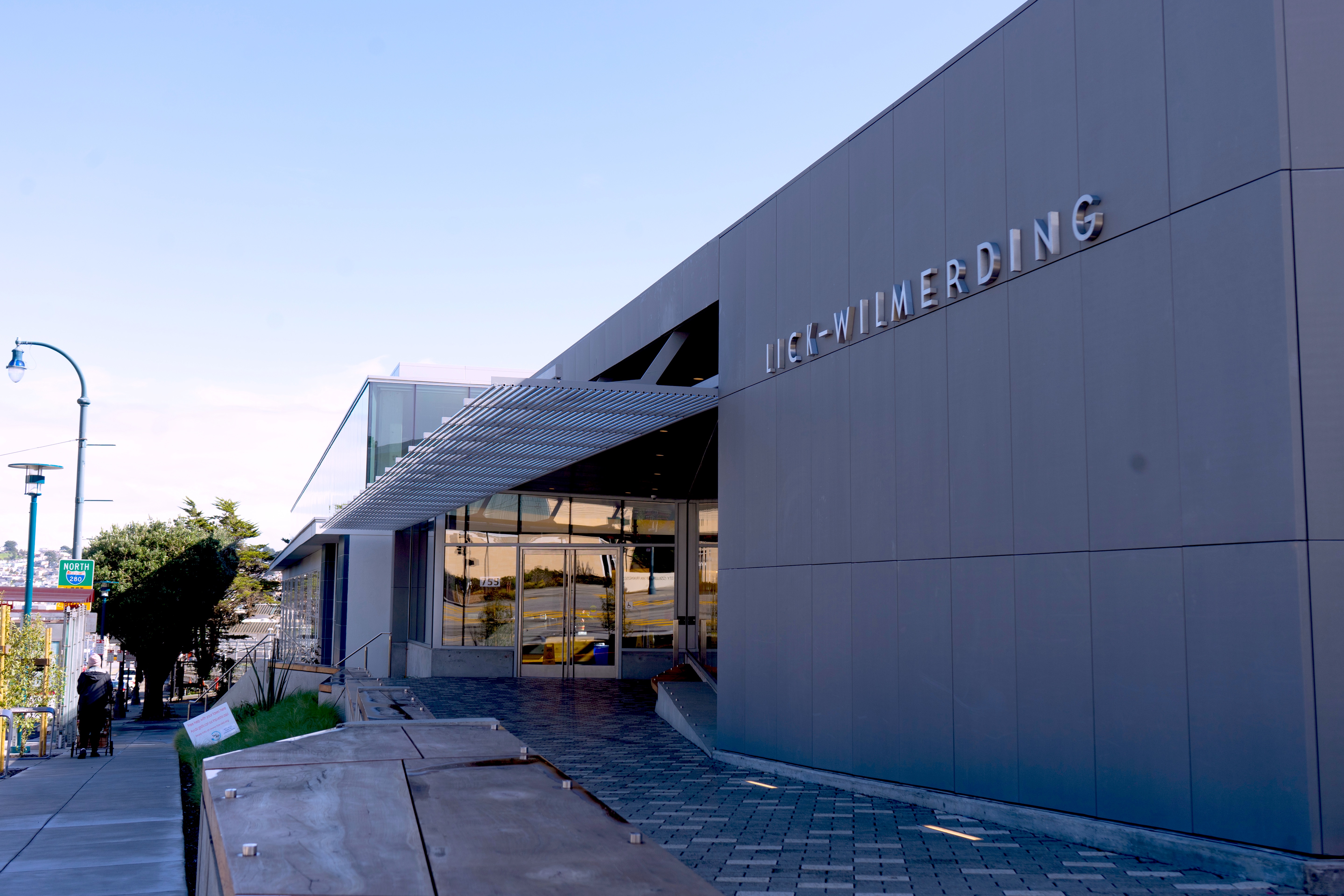When entering Lick Wilmerding’s new Ocean Avenue building, one of the school’s most ambitious projects yet, one can immediately witness the school’s values in action. What was once a two-story, mid-century style building is now a modern three stories, with floor to ceiling windows overlooking Ocean Avenue.
An inviting walkway lined with benches, shrubbery, and artwork leads to the entrance. Beyond the front doors, students lounge on the colorful furniture below a skylight that pours natural light into the foyer space. The Center for Civic Engagement faces the entry, looking out on neighboring City College of San Francisco. Elements as simple as art displays, student interactions, and The Center reflect Lick’s head, heart and hands mantra within the physical space of the school.
The new building was an expensive undertaking for the school. However, the previous circumstances proved that a new building was necessary. Goranka Poljak-Hoy, Lick’s visual arts department chair and architecture teacher, said that the former building was unable to meet Lick’s needs and goals. Poljak-Hoy was a member of the building committee, a group of parents and faculty entrusted with planning, timeline and the architectural design for the building. Throughout the process, she was able to voice her opinion and speak on behalf of the teaching experience. Poljak-Hoy was involved in both the architecture and interior design phases of the project.
Poljak-Hoy said that as a result of the increasing class sizes “it became almost impossible to schedule courses because space was limiting.” The school’s vision to have an integrated curriculum, entailing new courses that would reach across departments, was implausible because “there was no physical space to add more content or to even creatively use existing space.” Poljak-Hoy expresses that the need for a new building became “increasingly obvious.”
The school’s core curriculum, vision and values are outlined in its strategic plan, which is developed by the Strategic Planning Committee, comprised of trustees, administrators, and teachers, every five years. In a letter addressed to the LWHS community, head of school Eric Temple describes strategic planning as “a deliberative effort that includes identifying strengths and issues, as well as reaffirming values, envisioning an even better future, and then working toward it.” One of the goals in the previous strategic plan — Making the Future: Strategic Directions 2013–2018 — was to “plan for a connected campus.” The massive effort behind the project encountered many obstacles but was ultimately successful in its effort to create a space that would honor Lick’s mission.
EHDD, a company that has worked on several school-related projects in San Francisco, was selected as the architecture firm for the new building. Their website displays their commitment to “inspire people to live, work, and learn in more productive and meaningful ways.” Truebeck Construction was hired in 2016. The construction company’s vice president of preconstruction, Nick Pera ’91, is a Lick alumnus.
The front cement walkway creates a natural flow from the corner of Howth and Ocean into the front entrance of the school. Poljak-Hoy says that entering the school on a level plane allows for more accessibility and promotes a sense of ease. Students often gather on the benches lining the walkway. Poljak-Hoy sees this as “just about everything the school stands for… It is a community that nurtures compassion and collaboration. It’s a heartbeat of public purpose.”
As one walks through the doors they are welcomed by the lively buzz of the foyer. The ways in which faculty and students utilize the foyer emphasize two significant values: collaboration and community. Molly French, Lick’s receptionist, says “a part of what I do is developing relationships with students and parents. When I was in that little bungalow [the location of the front desk during the 2017-18 school year] I didn’t have the opportunity.” French “barely knew [the freshman class of 2017] at all,” revealing that the foyer is a common place where students interact with not only each other but also faculty such as French. Now that her desk faces the front entrance, she feels “much more in the swim of things.”
Additionally, compared to the design of the former building, the front desk, admissions, and other offices are now all on the same floor, making it easier for French to give visitors directions.
The foyer has fostered more connection among students, too. Anna Hochman ’21 says the foyer is a place “where you assume everyone will be,” taking away a sense of discomfort for her when not knowing where to go. Dylan Sibbit ’22 notes that the chairs in the foyer are very comfortable, and as a result, students are more inclined to both socialize and do homework in the space.
The building was designed with the intent of portraying and supporting Lick’s commitment to being a “private school with a public purpose.” In the old building, The Center was tucked away at the end of the hallway. Temple describes that it was “more of a destination, you had to purposefully go there.” By putting it next to lobby with a glass door that opens up, students are “able to organically interact with The Center.” Temple adds that the Center speaks to the “heart” of Lick’s “head, heart, hands motto” because of its commitment to public purpose, service, partnerships with other nonprofits and leadership opportunities, and because it serves as a “home for many students of color.”
New features of the building include “breakout spaces” (alcoves with tables and chairs) and conference rooms. Temple highlights the importance of having both closed-off and open spaces to cater to “the extroverts and introverts within our community.”
The day-to-day social life at Lick has changed since the addition of breakout spaces and hallways. Poljak-Hoy describes the hallways as “main arteries, but then there are these branches where students have space to gather with friends and meet with teachers,” referring to the breakout spaces. These spaces were thoughtfully and carefully designed. For example, when designing, they were aware of how the light would affect the breakout spaces and whether it would disrupt meetings and daily functions.
Olive Maunupau ’22 mentions that because certain “groups” tend to move through spaces, she is interacting with people that she hadn’t before. Hochman adds that the variety of places to go allows for more opportunity to interact with different people. Hochman and Maunupau both express that although the building is bigger, it still feels intimate.
Psychology and Anatomy & Physiology teacher Carrie Maslow views these spaces as a reflection of Lick’s ideals. “I think the break-out spaces reflect the value of collaboration, the emphasis on students’ owning their learning and becoming interdependent.
The three principle hallways within the building are lined with lockers. The majority of lockers on the bottom floor belong to freshman, so appropriately, freshmen tend to hang out in the lower hallway.
Sibbit says “It’s intimidating to be around people who are gigantic,” referring to upperclassmen. The lower hallway allows him to “be in a place where you can transition.”
Poljak-Hoy notes that “hallway culture, which was already very strong at Lick, now has a home.” With the addition of breakout spaces, students aren’t sitting on the floor in front of their lockers and “blocking circulation.”
Throughout the design process, Temple said that the team focused on creating classrooms that could be successful learning environments. When designing the classrooms, flexibility was a priority. This was accomplished through whiteboards on each wall, pushpin surfaces, and few built-in storage units, preventing a “front” of the classroom. The new features have enhanced the learning and teaching experience, embodying the “head” aspect of Lick’s motto.
Bridget Martin ’21 notes that the flexibility of the rooms’ orientation is favorable for working in table groups, confirming that Temple’s goal was achieved.
Temple says the classrooms haven’t expanded significantly, only 30-40 square feet larger. However, the ceilings were raised. Maunupau says that this adjustment makes classrooms feel less “stuffy and cramped,” and as a result, the environment is more conducive to learning.
One of the most significant changes in the classrooms is the new windows. Constructed from plexiglass, the windows are larger and thicker, making the rooms both brighter and quieter. Faith Dyogi ’22 thinks that the giant windows have enhanced her capability to learn because of the abundance of natural light.
The distinct materials in the building reference the “hands” aspect of Lick’s motto. The exposed pipes, ductwork, and combination of wood and metal used in many of the staircases speaks to the industrial history and sensibility of the school, specifically the shops program. Temple says that he was “glad that we kept the facade because it ties into the history of the school.”
The design of the school is modern and clean, far from elaborate and fancy. Poljak-Hoy said that this choice is very fitting to Lick’s environment and values because “nothing here is over the top. We go for quality.”
Poljak-Hoy speaks to the eco-friendliness of the building: “all the materials put in there are not to be harmful to nature and to our students and faculty as well. It’s really about taking care of each other.” Maslow adds that the eco-friendly elements “reflect the value of considering our impact on society.”
Poljak-Hoy hopes that the building will serve as a gathering space for the broader community, allowing the values that Lick espouses to take deeper root in the neighborhood. The building was designed to take Lick into the next century, ensuring that the history and mission of the school will be proudly represented well into the future.







